



Featured image: UBERMORGEN, CCTV, A Parallel Universe, (2013)
Rachel Falconer’s article is written in response to an interview conducted with lizvlx and Hans Bernhard from Ubermorgen. ‘userunfriendly’ is their first solo exhibition in London and presents a performative study of creeping paranoia. It is on show at Caroll/Fletcher Gallery through October until 16th November 2013.
“You one of those right wing nut outfits?” inquired the diplomatic Metzger. Fallopian twinkled. “They accuse us of being paranoids.” “They?” inquired Metzger, twinkling also. “Us?” asked Oedipa. The Crying of Lot 49 [1]
The Edward Snowden soap opera is far from over as the media and social commentators continue to perform a one-way polylogue with the absconded, muted Snowden. The furore and essentialist reactions directed towards Snowden, the latest in a burgeoning breed of leaky information gatekeepers, has resulted in a pervading sense of neuroses creeping across the digital commons. One of the many media stunts to emerge from this backdrop of encroaching paranoia was Kevin Poulsen’s encrypted open letter to Snowden on the Wired website [2] . With the theatrical opening gambit of: “Don’t read this if you aren’t him”, this mimetic conceptual poke served only to simulate a tunnel vision debate about the authenticity of the encryption, and several bravado attempts to crack the PGP key.
The Snowden case is symptomatic of our current condition of post-panoptic surveillance, whereby practices of data and behavior tracking have led to an extension of Foucault’s panoptic theories beyond the notion of hierarchical surveillance. Recent debates about post-panoptic practices indicate a shift from direct, embodied surveillance, to distributed, mobile surveillance manifested in the likes of PRISM, XKeystore and Tempra. The normalization of the “need to watch and be watched” generated by our information society is ruptured in this instance by Snowden.
The combination of public outcry – exemplified by the recent anti-surveillance march in Washington – and the intensified interest in the phenomenon of mass surveillance on the hype cycle, has resulted in a number of workshops and art exhibitions dedicated to “giving the power back to the people”. Eyebeam recently hosted PRISM Breakup [3], a three-day event programme of workshops and talks which sought to offset the publically perceived imbalance in our mutual surveillance society by making the tools of the anti-surveillance trade accessible to everyone. This strategy of using the ecology of the art institution as an alternative site of knowledge production, and a locus of retreat and pedagogical resistance, is well rehearsed in the history of contemporary art. However, by concentrating on providing the tools of counteraction against the omnipresent, invisible, panoptic enemy of surveillance, perhaps the bigger picture of the phenomena of neurotic binarisms and shifting psychological territories are in danger of being overlooked.
In contrast to these oppositional tactics, the artists and digital actionists, UBERMORGEN, approach phenomena such as Snowden, and other symptoms of perceived hyper-capitalism from a fuzzier, more ambiguous subjectivity. In their quest for knowledge production and social dialogue, the artists present and re-present the conditions of our global socio-political situation as physical and ephemeral catalysts of open-ended investigation. Through their encounter with the digital, they craft physical manifestations of data, acting as a mobile research unit producing knowledge about real life conditions that spike their interest. Their widely questioned claim to neutrality is defended in their Manifesto; they are very specific about their position as actionists as opposed to activists, and place the physicality of the human body and neurological system at the core of their practice: “we are not activists. we are actionists in the communicative and experimental tradition of viennese actionism – performing in the global media, communication and technological networks, our body is the ultimate sensor and the immediate medium”.[4]
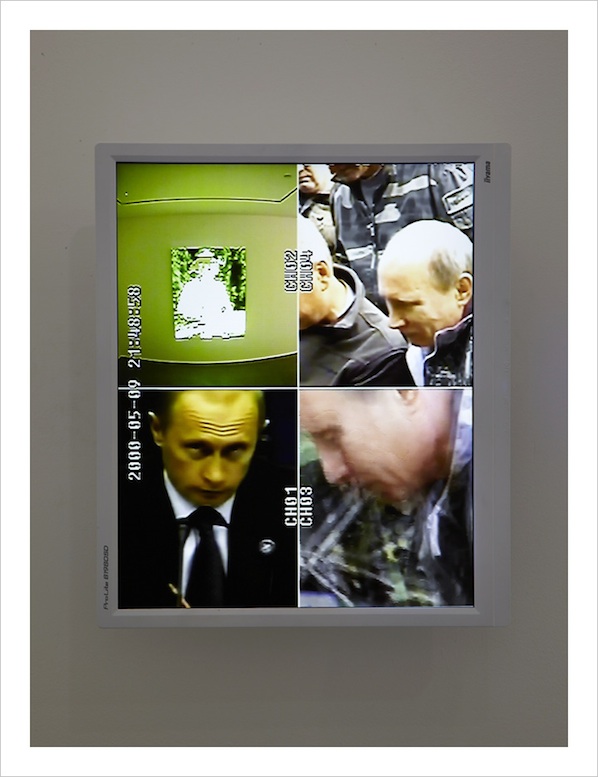
This position of political evasion hinges on a willful abstraction, and distancing from, their chosen subject matter. They activate this abstraction through their instinctive aesthetic strategy, creating a distance from the negative connotations popularly attributed to their subject matter by the media. The work Vladimir (2013) is a clear example of this obfuscating, poetic tactic the duo employ. Here, a CCTV monitor is split into four separate screens and located on the first floor of the gallery space. One screen shows the actual painting of Putin, (located in the lower gallery space). This takes the form of a pixelated painted canvas of Putin onto which an animated GIF is projected. Another screen from the CCTV plays footage of Putin at a press conference. On the remaining screens, there are images displaying alternative subjectivities of how Putin sees himself: heroic of the leader with a naked torso whilst partaking in the popular macho pursuits of fishing and shooting. These images are set up to relate to the animated canvas located and distanced in the lower gallery space. The relational dynamics between the works create a fragmented picture of the subject’s identity, and, as lizvlx suggests, this sense of abstraction and distancing through the aesthetics employed, neutralizes any characteristic of evil popularly associated with the subject himself. The viewer is left to come to an independent conclusion.
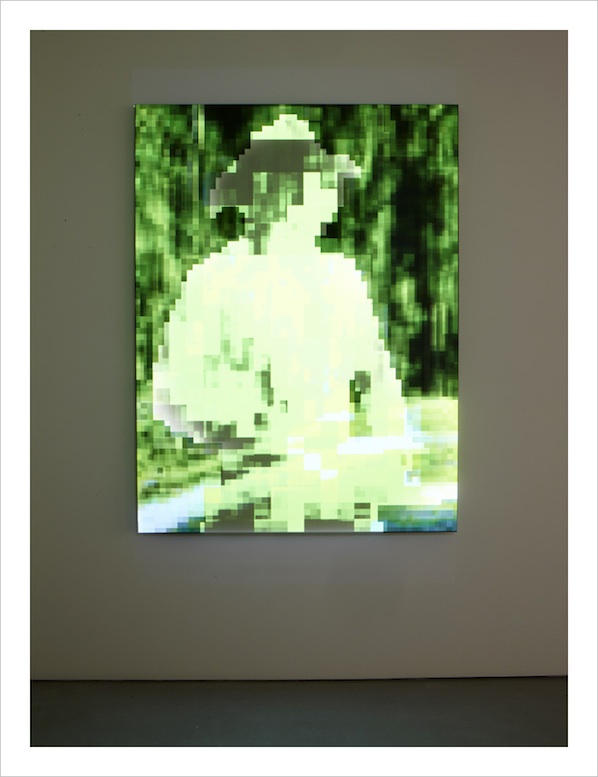
In fact, the entire show is a tightly choreographed relational synthesis. As I experience Hans and lizvlx’s all-encompassing Gesamtkunstwerk , I get the distinct, and unnerving impression that I am being watched. Call me paranoid if you will, but as I navigate through the show, I can’t help but notice that the familiar white cube space is punctuated and peppered by an abundance of CCTV cameras, staged situations of observation, identity –skewing overblown pixels, Crime Watch images and performative interrogation environments, placing the user cum visitor in an uncanny feedback loop of reactionary surveillance.
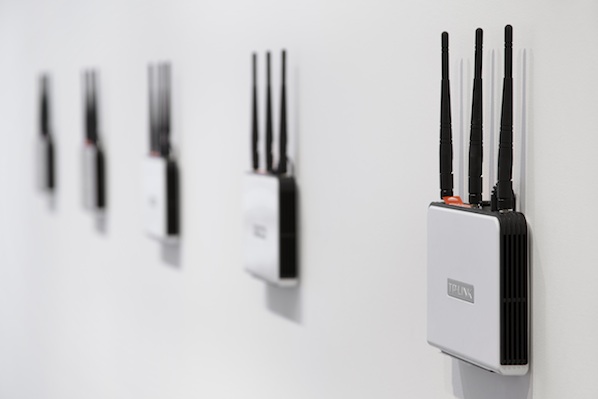
UBERMORGEN’s collaboration with Aram Bartholl, Net.Art (2013), is the first work I encounter as I enter the gallery. Bartholl’s OFFLINE ART [5] curatorial strategy takes the form of five wall mounted routers locally broadcasting a selection of UBERMORGEN’s net.art pieces disconnected from the Internet. These hermetically-sealed works make the visitor aware that they are being choreographed and controlled from the off – initiating the uninitiated and reminding those familiar with their work that it is never a comfortable ride. Bartholl’s new model of exhibition format is a subtle method of instilling a sense of self-awareness in the viewer. Throughout the show, UBERMORGEN continue to stimulate a gradual awareness, and partially expose, the systems of coercion, control mechanisms and surveillance techniques employed by institutions of public authority. As the tectonically-shifting position between fact and fiction continues to play out throughout the show, UBERMORGEN’s empirical probing of corporate and governmental control mechanisms becomes increasingly apparent.
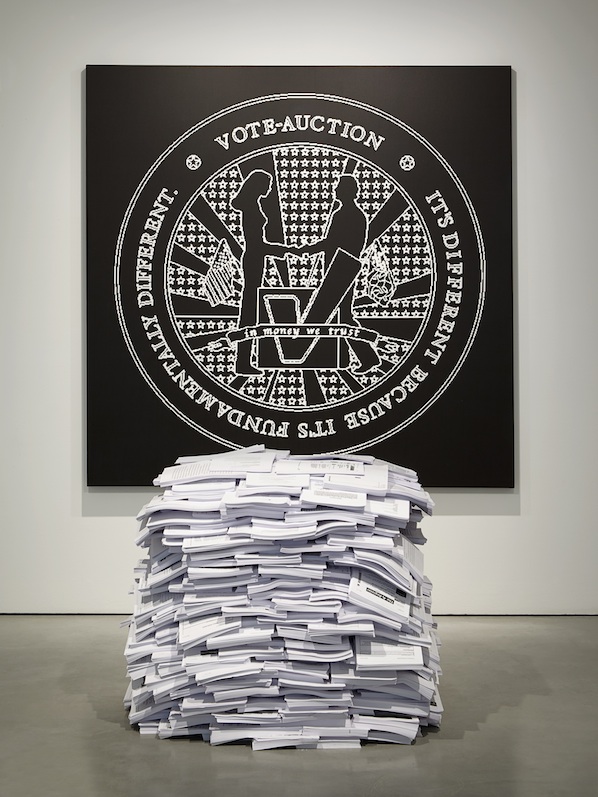
The historic work [V]ote-Auction(2000)- whose virtual subversion resulted in RL FBI intervention- is presented here as an impotent, dormant archive, its stacks of legal documents masquerading as a minimalist sculpture. However, the two new works CCTV(A parallel universe)(2013) and Do You Think That’s Funny? – The Snowden Files (2013) directly implicate the viewer in the act of surveillance. Both pieces are staged situations of observation and temptation. Do You Think That’s Funny is accompanied by a piece of pseudo fan fiction cum interview between UBERMORGEN and Edward Snowden available in the gallery catalogue. The installation itself is a contemplative, yet menacing frieze of control. According to the artists, they are in receipt of an encrypted data package from Snowden. The staged scenario tantalises the viewer/user by offering up Snowden’s dark data on wall-mounted Ethernet cables. A bench is provided for the viewer directly in front of the cables to contemplate the magnitude of their content. This meditative state is rudely interrupted by a looming white CCTV camera fixed to the parallel wall, levelled at the spectator. I am already aware of the presence of this electronic eye having encountered CCTV (A Parallel Universe) (2013), in the previous room. In this piece, the glaringly crisp images on the TV monitor clearly depict the panoptic gaze of the CCTV cameras installed in every part of the gallery, creating an infinite visual feedback loop.
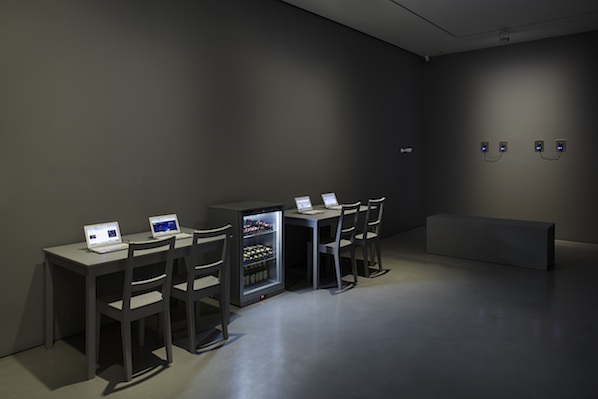
Call me paranoid, but as I navigate the exhibition, I become increasingly self-conscious. White cube galleries usually have the feel of surveyed environments, with their incumbent aura of silent contemplation, lurking invigilators and clearly posed CCTV cameras, but this is a different kind of watching. The fact that the work itself is not the main focus of the all-seeing eye of protection slowly dawns on me, and I feel that I am in fact the star of the show. As I crawl along the tunnel to reach the work Superenhanced (2013), I am aware of the fact that I am enacting a part, and white mice, hamster wheels and men in white coats come to my mind as I glimpse the two chairs and the hand cuffs ahead of me. As I look up and see that my confession can be clearly observed by visitors above me through the upper gallery stairwell, the picture is completed and I take my position in this physical simulation of a video game environment.
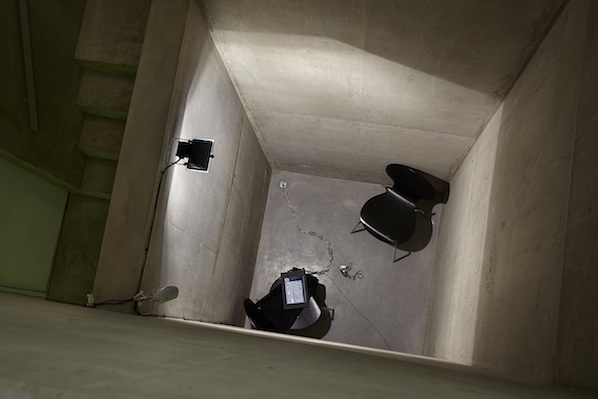
UBERMORGEN’s work implicitly involves and implicates both the visitor and themselves in a complex, and increasingly distorted feedback loop of knowledge production and surveillance. It is not, however, the surveillance of the Weiwei-esque, ever-present CCTV camera that starts to destabilise me, but the internal, cognitive surveillance prompted by the ambiguous narrative of the works. As the camera becomes assimilated and internalised, I am compelled to survey myself.